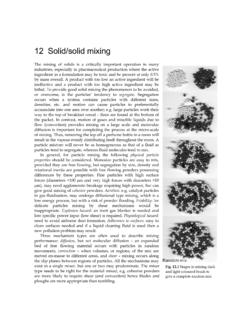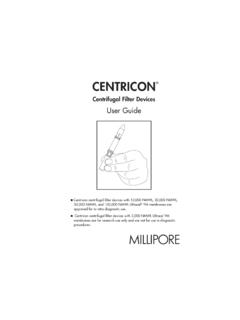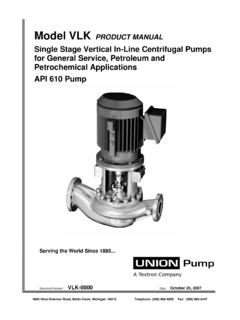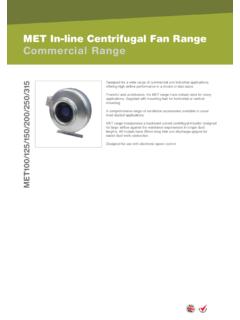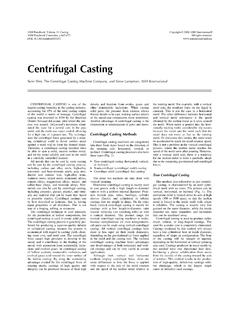Transcription of 8 Centrifugal separation - particles.org.uk
1 8 centrifugal separation The basic equations for most Centrifugal modelling were introduced in Chapter 5. The liquid drag force was given in equation ( ), under streamline flow, and the Centrifugal field force was provided in equation ( ). It is a simple matter to equate these to arrive at an analogue equation to the terminal settling velocity, equation ( ), but with one significant difference 18)(dd2s2rxtr = ( ) the distance with time differential is not constant. In a Centrifugal field the particle moves radially, see Figure and equation ( ), and the radial position is part of the field force hence the particle accelerates during its travel in the radial direction.
2 Thus, to determine the particle position as a function of time integration is required. It is well known that from a strict physical definition of forces on a particle, in circular motion, the centripetal force and not the Centrifugal force should be considered. An unrestrained particle would leave its orbit tangentially if the centripetal force was suddenly removed. This is what happens with particles in cyclone separation from gases and this is discussed further in Chapter 14. However, this chapter is concerned with separation of particles in rotating flow within a viscous medium, usually water.
3 The particle will not travel tangentially to one orbit, but to lots of orbits, giving the impression of radial movement outwards (provided the particle is denser than the surrounding continuous phase). Mathematically, we can use the well-known expressions, such as equations ( ) and ( ), to describe this travel. As illustrated in Figure , the Centrifugal acceleration is simply the product of the radial position (r) and the square of the angular velocity ( ). The SI units of angular velocity are s 1, but calculated by converting from revs per minute (rpm) into radians per second then ignoring the dimensionless radian term.
4 In solid body rotation, such as a centrifuge, this is easily calculated from the rotational speed, usually provided in rpm. Thus, 1 rpm is 2 s 1 as an angular velocity. In free body rotation, such as the hydrocyclone, the angular velocity is calculated from the tangential velocity (u ) by ru = ( ) this is also illustrated on Figure In the hydrocyclone the principle known as the conservation of angular momentum is used; in which knowledge of the tangential velocity at any radial position can be used to calculate the tangential velocity at another because constant22 11 ==ruru ( ) Buoyancy If a particle floats, rather than sinks, then it will move inwards in a Centrifugal field.
5 Particlesdenser than the fluid will move outwards. The Centrifugal field acts like an enhanced gravitational field in equation ( ) and it is usual to speak in terms of the equivalent g force: Centrifugal acceleration / m s 2. Fig. Particle in rotation and definitions 78 Centrifugal separation or to take account of frictional losses within the hydrocyclone constant"22 "11 ==nnruru ( ) where n is an empirical constant, usually between and 1. In filtration within a Centrifugal field the body force acts on the liquid, which can pass through the filter medium, or septum, similar to a washing machine or spin drier.
6 The rotation acts in a similar way as increasing the pressure effecting the filtration and it is possible to deduce what this equivalent pressure difference is, using an equation analogous to that given by the static component of Bernoulli s equation (depth x density x acceleration) 2/)(2L2o2 CHrrP = ( ) where ro is the radius of the centrifuge and rL is the inner liquid radial position and PCH is sometimes called the Centrifugal head. From all of the above, it should be apparent that modification of the equations discussed in Chapters 4 and 5, for an enhanced body force due to rotation is simply required.
7 Sedimenting centrifuges The analogue continuous gravitational equipment design, to centrifuges, was covered in Section Applying a similar logic to the critical trajectory model illustrated in Figure , the critical particle enters the centrifuge at radial position rL and leaves at radial position ro assuming that the particle is denser than the liquid, see Figure Equating the times taken for the particle to move radially and for it to progress axially provides the following expressions, based on equations ( ) and ( ) ()Lo2s2/ln1)(18)axial(rrxt = ( ) ()QLrrt2)radial(2L2o = ( ) where the equation ( ) is the volume of the machine divided by the volume flow rate; analogue to equation ( ).
8 Combining these equations and multiplying through by the acceleration due to gravity ()()2 Los22L2o/ln)(182 rrggxQLrr = The term in the square brackets is the terminal settling velocity under gravity, equation ( ), making this substitution and rearranging gives ()()Lo22L2ot/lnrrgLrrUQ = ( ) It is notable that the left hand side of equation ( ) is identical to the left hand side of equation ( ). Thus, equation ( ) represents a centrifuge that has the same settling capacity as the plan area of a Fig. Critical particle trajectory in a centrifuge Fundamentals of Particle Technology 79 gravity settling basin.
9 This is illustrated further as follows, the parameters that are defined by the process are called sigma-process =tprocessUQ ( ) for a given particle size there will be a certain flow rate (Q) at which all particles of this size are removed. If this flow rate is exceeded then particles of this size start to appear in the effluent. Thus, the process variables (size and flow rate) defines the sigma value. If the centrifuge is 100% efficient, the sigma process will be equal to the machine based parameters, called sigma-machine ()()Lo22L2omachine/lnrrgLrr = ( ) Both equations ( ) and ( ) have the SI units of area and both represent the theoretical plan area of a gravity settling basin that would perform the same separation duty on the solids.
10 Introducing an efficiency factor (EA) to take account of poor flow distribution within the machine and other factors reducing the separation capacity gives ()()Lo22L2oAt/lnrrgLrrEUQ = ( ) It is worth noting that, under gravity, particles less than 2 m in size might not settle because of molecular bombardment from the liquid and colloidal forces. However, in a Centrifugal field the body force is much stronger and these particles have a greater chance of settling. Hence, a separation that might not be possible under gravity might be possible in a centrifuge.



